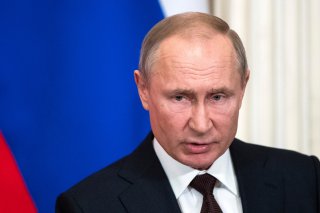Nuclear Arms Race? Can America and Russia Save New START?
The Treaty between the United States of America and the Russian Federation on Measures for the Further Reduction and Limitation of Strategic Offensive Arms—also known as the New START Treaty—was signed in 2010 and it entered into force on February 5, 2011. It is set to expire in February, and there has been no significant effort to see it extended.
Last Friday, Russian foreign minister Sergey Lavrov said during a meeting with President Vladimir Putin and permanent members of the Security Council that it was ready to work with the United States on new strategic stability and arms control treaties—also known as the New START Treaty.
“Dear Vladimir Vladimirovich [Putin], on your instruction we have been in quite intensive contact with our American colleagues on the entire range of strategic stability issues, in particular, we are stressing your initiative that remains in force and is becoming increasingly important on making a decision on extending the current New START Treaty [the Treaty on Measures for the Further Reduction and Limitation of Strategic Offensive Arms], which expires in February, without any preconditions. Meanwhile, we confirm that we will be ready to continue work on new accords,” Lavrov said as reported by Tass.
“With your consent, we put forward specific proposals on developing a comprehensive approach towards strategic stability that were transferred to the U.S. side,” Lavrov added. “In response, the Americans gave us their proposals that were presented as preconditions of extending the New START Treaty. Moreover, these preconditions are quite numerous.”
The Treaty between the United States of America and the Russian Federation on Measures for the Further Reduction and Limitation of Strategic Offensive Arms—also known as the New START Treaty—was signed in 2010 and it entered into force on February 5, 2011. It is set to expire in February, and there has been no significant effort to see it extended.
Missile Limitations
The New START Treaty stipulated that seven years after its entry into effect each party should have no more than a total of seven hundred deployed intercontinental ballistic missiles (ICBM), submarine-launched ballistic missiles (SLBM) and strategic bombers, as well as no more than 1,550 warheads on deployed ICBMs, deployed SLBMs and strategic bombers, and a total of no more than eight hundred deployed and non-deployed ICBM launchers, SLBM launchers and strategic bombers.
As noted the New START Treaty is set to expire in February unless superseded by a subsequent agreement. It could be extended for a period of no more than five years, which would be 2026 upon the mutual consent of both parties. Moscow has reportedly called on Washington not to delay such an extension.
New Arms Race
Failure to extend the treaty could result in a new escalation of arms, and there have been calls not to allow that to happen.
“Putin’s proposal would buy additional time for diplomacy,” said Robert Litwak, the senior vice president at the Wilson Center and author of Managing Nuclear Risks, in an email to the National Interest.
“The demise of the foundational New START treaty could usher in an era of unconstrained nuclear competition between the United States and Russia with potentially destabilizing consequences,” added Litwak.
The issue however is that Washington and Moscow may not be on the same page for what they expect from such a treaty.
“After several rounds of talks, the U.S. and Russia each offer a slightly different vision for the New START extension,” said Matthew Rojansky, the director of the Kennan Institute on Russia and the United States, who also shared his thoughts via an email. “Both sides agree that, per the terms of the original 2011 treaty, it can be extended for another five years by mutual agreement.”
There are factors for the United States to consider, however, notably that Washington must deal with not only Moscow but also Beijing—as China continues to increase the size of its military, notably its navy, which has now become the largest in the world.
“The Russian side has offered such an extension, ostensibly ‘without preconditions.’ However, the U.S. side, noting changing the global security context especially increasing tensions with China, has sought to negotiate a more expansive deal,” suggested Rojansky.
“Initially, the Trump administration sought a three-way agreement that would include China,” Rojansky added. “More recently, senior U.S. officials have described an ‘agreement in principle’ with Russia to freeze warhead numbers on both sides, but the Russians have not confirmed this. What it amounts to is continuing uncertainty whether the New START agreement will be extended before February 2021, when it is otherwise set to expire.”
Peter Suciu is a Michigan-based writer who has contributed to more than four dozen magazines, newspapers and websites. He is the author of several books on military headgear including A Gallery of Military Headdress, which is available on Amazon.com.
Image: Reuters

